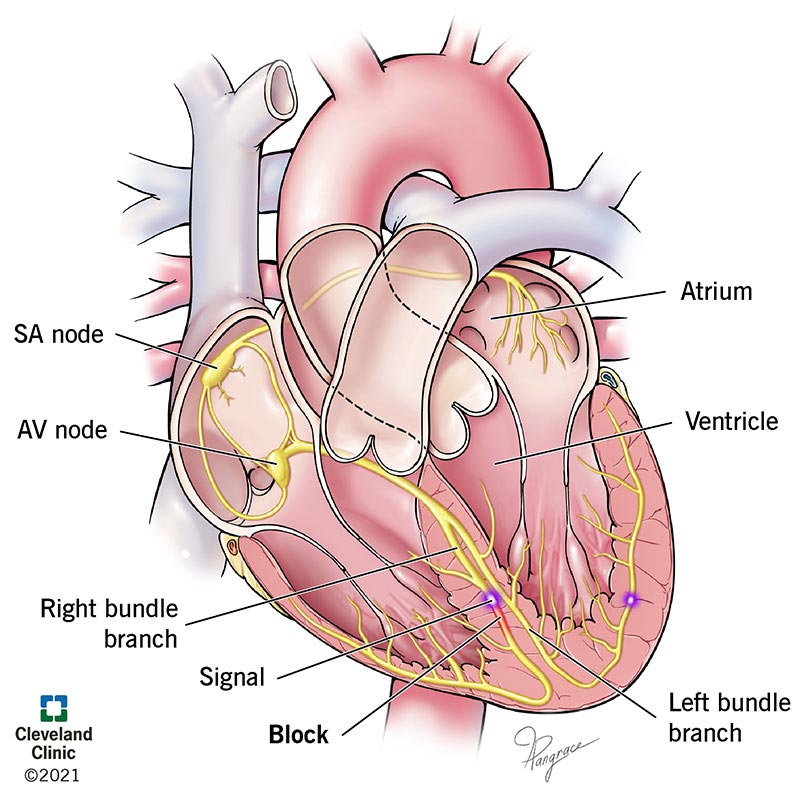Right bundle branch block is a problem with your right bundle branch that keeps your heart’s electrical signal from moving at the same time as the left bundle branch. Instead of moving together on the left and right sides, the signal on the right side is running behind. This creates an irregular heartbeat. Usually, the problem isn’t serious.
Advertisement
Cleveland Clinic is a non-profit academic medical center. Advertising on our site helps support our mission. We do not endorse non-Cleveland Clinic products or services. Policy

Right bundle branch block is an obstacle in your right bundle branch that makes your heartbeat signal late and out of sync with the left bundle branch, creating an irregular heartbeat.
Advertisement
Cleveland Clinic is a non-profit academic medical center. Advertising on our site helps support our mission. We do not endorse non-Cleveland Clinic products or services. Policy
Electrical signals in your heart act like a pacemaker that controls your heartbeats. This signal starts in the sinoatrial (SA) node, which tells your left and right atria (upper heart chambers) to contract. Next, the signal goes to your atrioventricular (AV) node and bundle branches, which make your left and right ventricles tighten.
Normally, the signal goes down both bundle branches at once and both ventricles are working at the same time. When the signal goes down the right bundle branch a little slower than the left bundle branch, the right ventricle contracts later than the left one. This is what’s going on when you have a right bundle branch block, and it happens because the signal has to go around a block in the branch.
Because the ventricles aren’t working at exactly the same time, this creates an irregular heartbeat (arrhythmia.)
Right bundle branch block can be complete or incomplete. Unlike complete right bundle branch block, incomplete right bundle branch block doesn’t increase your risk of heart attack and death.
Right bundle branch block can happen in healthy people. It’s more likely to happen in older people.
You most likely won’t have any symptoms.
There are several causes of right bundle branch block, including:
Advertisement
A provider often finds it during an annual physical.
Your healthcare provider will review your electrocardiogram (EKG) results carefully to make sure you don’t have a different problem, such as:
Usually, if you don’t have symptoms and you don’t have heart disease, you don’t need treatment for right bundle branch block.
Right bundle branch block may stay the same without any change or the block may progress to involve other conduction branches.
Right bundle branch block doesn’t go away.
Your outlook depends on whether you have cardiovascular disease. If you don’t have heart disease, having right bundle branch block doesn’t change your life expectancy or add to your risk level. But having right bundle branch block can put you at a higher risk of death if you also have heart failure or a heart attack.
If you don’t have symptoms and you don’t have heart disease, you don’t need to do anything for right bundle branch block. But if you’ve had other problems like a heart attack or heart failure, you need to continue with treatment for those issues.
You should see your provider if you have other heart problems in addition to right bundle branch block.
You should go to the ER if you think you’re having a heart attack.
Many people have right bundle branch block, especially as they age. About 11% of people have this by the time they’re 80.
If you have no symptoms and no heart disease, a right bundle branch block is not serious. But if you’ve already had heart failure or a heart attack along with right bundle branch block, it puts you at a higher risk of death.
Yes.
Right bundle branch block isn’t a cause for worry if you don’t have symptoms or heart disease. But when you have right bundle branch block and you’ve already had a heart attack or heart failure, you should focus on continuing with treatment for those problems. Be sure to follow your provider’s treatment plan for the best results.
Advertisement
When your heart rhythm is out of sync, the experts at Cleveland Clinic can find out why. We offer personalized care for all types of arrhythmias.

Last reviewed on 08/09/2021.
Learn more about the Health Library and our editorial process.